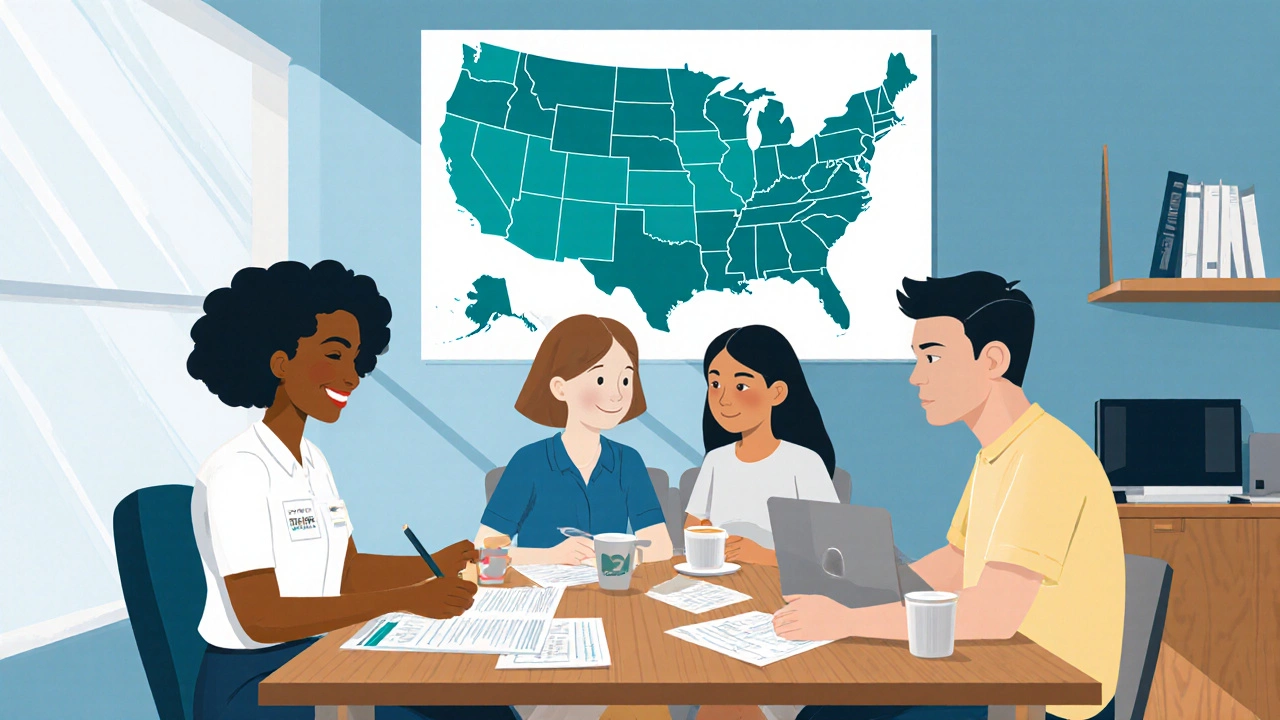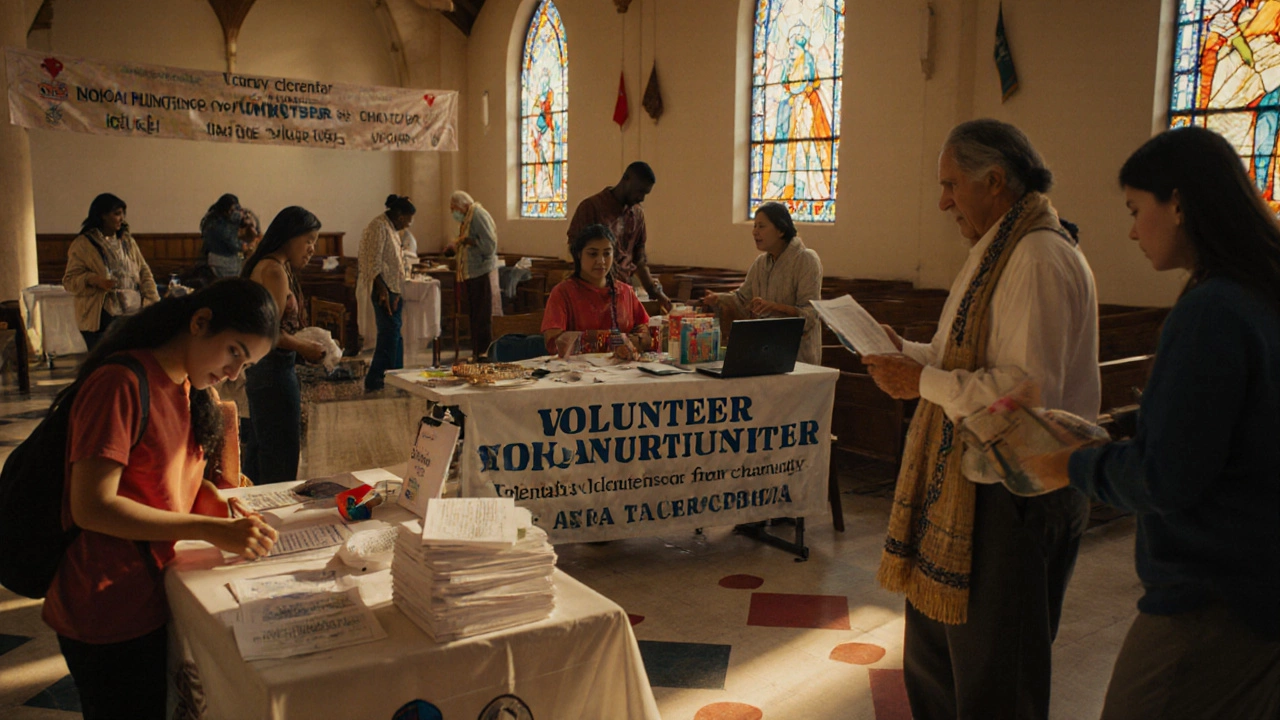Racial Group Volunteer Participation Calculator
Compare Volunteer Statistics by Race
Enter a percentage to see how many volunteers would be expected in a group of your choice.
Results
Key Takeaways
- White adults volunteer at the highest overall rate in the United States, followed by Black, Hispanic, Asian, and Native American groups.
- Volunteer hours per capita are strongest among Black and Hispanic volunteers, even when overall participation is lower.
- Socioeconomic status, cultural norms, and community ties explain many of the differences across racial groups.
- Regional factors matter: states with strong nonprofit ecosystems show smaller gaps between groups.
- Nonprofits can boost under‑represented participation by offering culturally relevant roles and removing hidden barriers.
Ever wonder why some communities seem to fill every food‑bank line while others stay quiet? Volunteerism is the practice of offering time and skills without pay to support community goals isn’t just a feel‑good activity-it’s a measurable force shaping public health, civic engagement, and local economies. Understanding the volunteering demographics behind that force helps charities target support where it’s needed most. Below we break down the latest numbers, explore why the gaps exist, and give you concrete ideas to level the playing field.
How Volunteer Rates Are Measured
Most of the hard data comes from the United States Census Bureau the federal agency that collects demographic and socioeconomic data, including volunteer statistics. Each year the Bureau’s Current Population Survey asks a random sample of adults whether they performed any unpaid work for a charitable organization, religious group, school, or local cause in the past 12 months. The responses are weighted against Demographic Data age, income, education, and race/ethnicity information that lets researchers slice the volunteer pool to produce rates by race, gender, age, and region.
National Snapshot: Overall Volunteerism
In 2024, about 30% of U.S. adults reported volunteering at least once over the past year, delivering roughly 1.1billion hours of service. That translates to an average of 52 hours per volunteer-just enough to fill a full‑time job for a month. While the overall figure has nudged up from the pandemic dip, the distribution across racial groups tells a more nuanced story.

Volunteer Participation by Race/Ethnicity
The table below pulls the latest Census Bureau numbers and adds a few sector insights from Nonprofit Organizations entities that rely on volunteers for everything from disaster relief to youth mentoring. Percentages reflect adults (18+) who volunteered at least once in the last year. Hours are averages per volunteer.
| Racial/Ethnic Group | % Adults Who Volunteered | Avg. Hours per Volunteer | Top Volunteer Sector |
|---|---|---|---|
| White | 33.2% | 48 | Community Service (food banks, shelters) |
| Black / African American | 30.8% | 62 | Faith‑based outreach |
| Hispanic / Latino | 28.1% | 58 | Youth mentorship |
| Asian | 24.3% | 42 | Education tutoring |
| Native American | 22.7% | 40 | Cultural preservation projects |
Why the Gaps Exist: Socioeconomic & Cultural Factors
Two forces drive the numbers above: Socioeconomic Status income, education, and employment stability that shape one’s ability to give time and Cultural Norms community expectations, religious practices, and family responsibilities that influence volunteering attitudes. Higher median incomes among White households translate to more flexible schedules and access to transportation, making occasional volunteering easier. Meanwhile, Black and Hispanic volunteers often report stronger community ties and a cultural emphasis on mutual aid, which explains their higher average hours despite slightly lower participation rates.
Education also matters. A 2023 study by the Center for Community Innovation found that people with at least a bachelor's degree are 1.6times more likely to volunteer than those with only a high school diploma. Since college attainment varies by race, that gap feeds directly into the overall percentages.
Regional Variations: State‑Level Insights
Geography can compress or widen the gaps. In states like California, Washington, and NewYork-where nonprofit density and public‑transport options are high-the Black‑White participation gap shrinks to under 3percentage points. Contrast that with Mississippi or WestVirginia, where limited transportation and fewer organized volunteer opportunities keep the gap above 8 points.
Urban centers add another layer. Cities with sizable immigrant populations (e.g., Houston, Atlanta) show higher Hispanic volunteering rates, especially in schools and community health clinics, thanks to targeted outreach programs run by local faith groups.

How Nonprofits Can Boost Participation Across Groups
If you run a charity, there are three practical steps to attract under‑represented volunteers:
- Speak the community’s language. Offer materials in Spanish, Arabic, or other prevalent languages and highlight cultural relevance in role descriptions.
- Lower logistical barriers. Provide transportation vouchers, childcare stipends, or flexible scheduling that fits shift‑work patterns common in many minority households.
- Partner with trusted institutions. Faith churches, community centers, and schools act as bridge builders. Co‑host events or embed volunteer opportunities within existing community programs.
Data from Community Service the umbrella term for unpaid activities that benefit the public, ranging from cleanup drives to mentorship shows that organizations that adopt at least two of these tactics see a 12‑18% lift in volunteers from minority groups within a year.
Common Misconceptions About Race and Volunteering
Myth #1: “Minorities don’t care about volunteering.” In reality, many Black and Hispanic volunteers devote more hours per year than their White peers; the gap lies in fewer opportunities rather than lack of interest.
Myth #2: “Asian Americans are the least civic‑engaged.” While participation rates are lower, Asian volunteers often focus on education‑related tutoring-a high‑impact sector that doesn’t always get counted in broad surveys.
Myth #3: “Native communities aren’t involved.” Many tribal nations run their own volunteer networks for cultural preservation, but these efforts are under‑reported in national datasets.
Frequently Asked Questions
Do volunteer rates differ by age within each racial group?
Yes. Across all races, adults aged 45‑64 volunteer the most, followed by 25‑44. Younger adults (18‑24) show the lowest rates, but their hours per volunteer are rising thanks to college‑based service‑learning programs.
How reliable are the Census Bureau’s volunteer statistics?
The data are nationally representative and based on a large probability sample, but they rely on self‑reporting. Some under‑reporting occurs in groups with limited internet access, so local‑level surveys can provide a more nuanced picture.
What sectors attract the most diverse volunteers?
Faith‑based outreach, youth mentorship, and community health clinics consistently draw volunteers from a broad racial mix. These sectors often partner with local churches, schools, and clinics that already serve diverse populations.
Can virtual volunteering reduce racial gaps?
Virtual roles help remove transportation and scheduling barriers, especially for those juggling multiple jobs. However, digital‑access gaps mean nonprofits must also provide low‑tech alternatives to keep participation inclusive.
What’s a quick win for a small charity wanting more minority volunteers?
Host a short volunteer‑info session at a local church or community center, bring a bilingual volunteer coordinator, and offer a one‑hour “try‑out” shift with free coffee. The low commitment and familiar setting often convert curious attendees into regular helpers.
